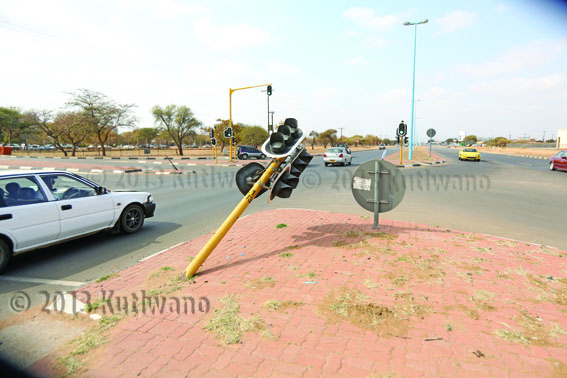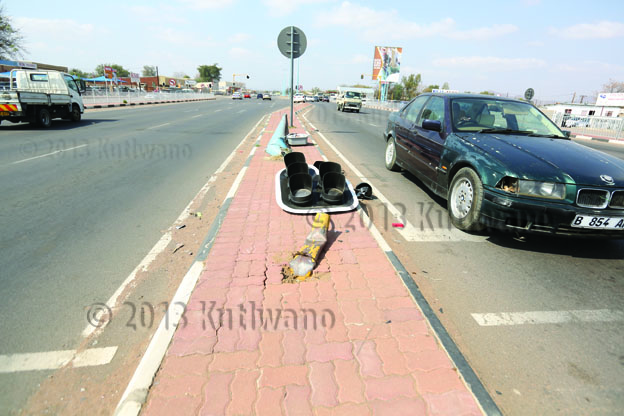THE MISERY THAT MOTORISTS BRING TO TRAFFIC LIGHTS
Source : Kutlwano
Author : Thamani Shabani
Location : GABORONE
Event : Outlook
At the time of writing this story there were 20 damaged traffic lights and no less than ten damaged lampposts in the stretch between Molapo Crossing in Gaborone and Metsimotlhabe. The lights had either been flattened or completely uprooted by some careless motorists.
The destruction of the lights was by no means planned but you guessed right; it was carried out by humans. And all the humans had one or more things in common.
They all were driving a motor vehicle – no scooters here; they were careless, negligent or both - that includes running red lights or insisting on the right of way even in the face of danger from a less brilliant driver. Not all, but most of the drivers were drunk or were suffering from a hangover. Lastly there is the small group of unlicensed and inexperienced but licensed drivers.
Friday nights and Saturdays following pay days – normally the week of the 20th of every month - tend to own the larger share of the destruction. How that is so, needs no rocket scientist to decrypt.
In their element, the drunks will make it a point to take down a lamp or traffic light that was mounted a few hours earlier. Unless their vehicle threatens to blow up into a fireball due to a leaking fuel tank or some broken engine component, these drunk drivers – most of whom are young men, often take off to avoid the charge of drunken driving. If the vehicle cannot move, they slither into the darkness, only to come back to the police station sober, hours, or even a day later and tell the officers some tale.
Now because traffic lights have been damaged, the remaining lights are either perpetually blinking red, altogether off, or allowing only vehicles from one direction through. By some miracle, Gaborone city drivers have learnt to live with this inconvenience. While there have been casualties, there are not as many as those that happen in other countries.
To aid traffic movement, the police have also made it a point to assign an officer or two at the city`s busiest intersections. The arrangement has so far worked well except when it rains or when weather conditions simply would not allow them to be there. And woe to the driver who visits the city on such a day! “Going through so many malfunctioning traffic lights is a nightmare,” says Tebatso Boikanyo of Mochudi. She says a Monday drive along Gaborone roads especially the Western By-pass is an enormous challenge that calls for patience, diligence and even bravery.
From the time she enters Gaborone at Phakalane, Boikanyo resigns herself to the 45-minute crawl to her workplace. If she has to avoid the slowly painful drive, she wakes up as early as 4am. She is convinced people who destroy lights are drunken drivers, considering the lights are damaged only late Fridays and weekends.
But there is a way to deal with reckless drivers who take off after knocking down traffic lights, says Jimmy Moleofi. Garage owners, he says, must report people who bring vehicles to them and do not have a police report. Those who fail to report should be charged along with the culprits once they are arrested. This is because people who damage traffic lights cost the taxpayer a lot of money. Panel beaters who help them are partaking in this evil too.
Consider these figures from AON Insurance Company which covers Gaborone City Council property including street and traffic lights: one traffic light costs between P15 000 to P20 000. A traffic pole costs between P2 000 and P3 000. Add that together and you see that each time someone takes out a traffic light it is not a little money spent repairing it. And that is not all.
There is the contactor fee to top it all. “After we receive a claim from GCC, with details of the third party, we pay for replacement of the lights and then claim the amount from that person,” says AON Insurance Company Fund Administrator, Barnabas Mavuma.
He says it is the responsibility of GCC to make all the effort to trace motorists who knock down traffic lights and street lights, and provide a police report and a quotation for the claim to succeed.
And it is not easy to trace the wrongdoers. So fed up with these people, GCC has decided to introduce an intervention project aimed at upgrading traffic lights and installing a Centralised Command Centre. The decision follows a world Bank funded Botswana Integrated Transport Project study whose sub-component, the Greater Gaborone Multimodal Transport identified mitigation measures to congestion and malfunctioning of traffic lights, according to a former GCC acting chief civil and mechanical engineering officer, Khumo Manyathelo. The study was completed in 2011.
The conceptual design of the project will be to look into and come up with real time operation of traffic lights linked to the control room. To that end selected corridors will have CCTV cameras monitoring traffic lights on a 24 hour basis. That should make it easier to nab traffic offenders who destroy the city`s traffic lights.
The conceptual design is expected to take about six months followed by a 24 months construction phase.
Another project identified is the upgrading of three traffic circles into traffic light controlled intersections. These will be the circles at Botswana Television (BTV), Rainbow and Game City. That is expected to enhance traffic management in the city. ENDS
Teaser:
Consider these figures from AON Insurance Company which covers Gaborone City Council property including street and traffic lights: one traffic light costs between P15 000 to P20 000. A traffic pole costs between P2 000 and P3 000. Add that together and you see that each time someone takes out a traffic light it is not that little money will be spent repairing it. And that is not all.














